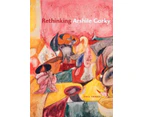Rethinking Arshile Gorky

Often referred to as the last Surrealist and first Abstract Expressionist, Arshile Gorky (c. 1900-1948) appears as an interstice within art history's linear progression. Gorky embraced dream imagery in the tradition of the Surrealists, used all-over patterning before Jackson Pollock, promoted disembodied color before Mark Rothko, exploited the physicality of paint before Willem de Kooning, and anticipated stain painting. His life - he escaped the Armenian Genocide of 1915 and struggled as an immigrant artist in New York in the 1930s and 1940s - and his tumultuous personal relationships have cast the artist as a tragic figure and often overshadowed the genius of his art. "Rethinking Arshile Gorky" is an examination of the artist and his work based on themes of displacement, self-fashioning, trauma, and memory. By applying a multitude of techniques, including psychoanalytic, semiotic, and constructivist analyses, to both explain and demythologize the artist, Kim Theriault offers a contemporary critique of both the way we construct the idea of the 'artist' in modern society and the manner in which Arshile Gorky and his art have historically been addressed.
